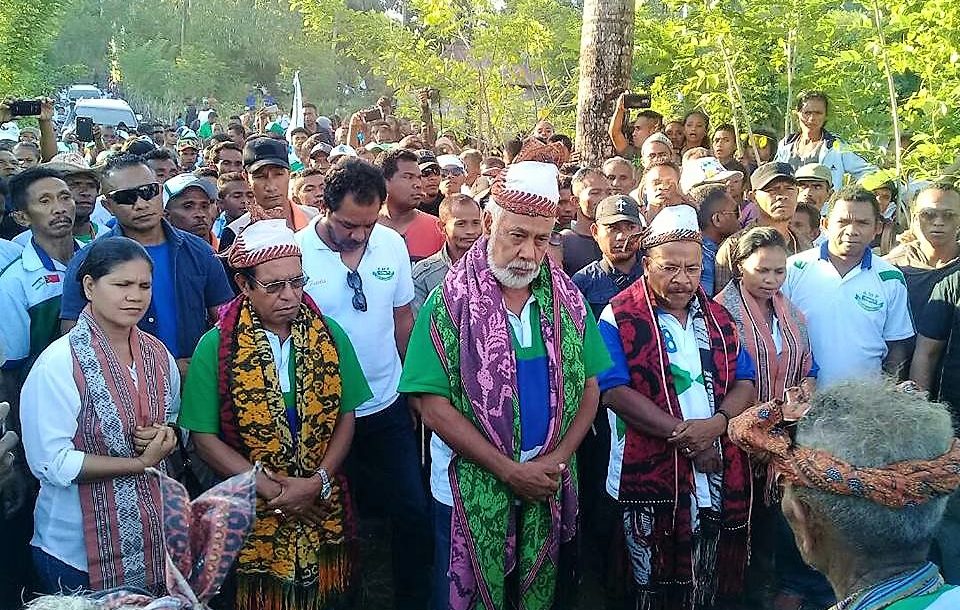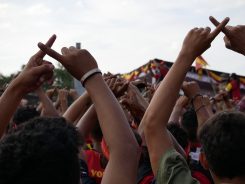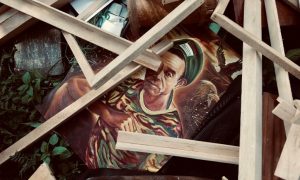Edited extract from Island Encounters: Timor-Leste from the outside in (ANU Press, 2021).
Timor-Leste turns 20 on the 20th of May 2022. It has a freshly minted new (and former) president, Dr Jose Ramos Horta who will be sworn into power on the same day. Fresh parliamentary elections await a date to be fixed sometime over the next 12 months.
Xanana Gusmao paces in the wings. After his party was unexpectedly out-manoeuvered by his rivals in a government shake-up in 2019, he seems intent on regaining formal control. Yet whether he has ever lost actual control of the tiny nation of 1.3 million is an entirely different question. The former resistance leader was Ramos Horta’s kingmaker in 2008 and 2022, as Xanana has been the kingmaker for every other president in the country’s two decades long history. In 2002 he himself was the president.
In the 2018 parliamentary elections, Xanana Gusmao, leading his political party CNRT, ran for government invoking lulik sacred ancestral power with two other heavy hitting leaders. His own power as the pre-eminent FALINTIL armed resistance hero during the Indonesian occupation, then as former president and prime minister of the new nation was joined to that of former president and FALINTIL commander Taur Matan Ruak and rural youth and mystic martial arts leader from the central mountains, Naimori. Through their speeches it became apparent that the three had aligned themselves (and their political campaign) with the three sacred mountains of Timor-Leste.
In this consubstantiation, Xanana’s power was linked to the country’s tallest and most sacred mountain Rame Lau, Taur with Matebian, the “mountain of the dead” in the east, and Naimori with the third tallest mountain, Cabalaki, which was the stronghold in the early 20th century of Timor’s first “nationalist” hero, Dom Boa Ventura.
During their final political rally in 2018, Xanana Gusmao was singled out by his running mates Taur and Naimori for the greatest praise. They both referred to him as Timor’s greatest ever leader. Xanana himself did not make a speech. Instead, he chose to take on a role akin to that of court jester, humouring and exciting the crowd with his larger-than-life body language and antics. All the while, Xanana said very little. He didn’t need to speak; his mystique and power preceded him.
The enigma of Xanana was clearly revitalised in that election campaign. His CNRT party had lost the previous year’s elections on what might be considered a modernising ticket of progress and mega-projects. President Lu Olo had given his FRETILIN party (who had won the most—but not majority—seats) the opportunity to form a minority government. Devastated by the shock loss, Xanana had left the country for many months. He justified this absence as necessary for him to focus on renegotiating the Timor Sea Maritime Boundary Treaty that would finally resolve the decades-old oil and gas dispute with Australia. At a distance, Xanana began to regroup politically.
Back in Dili, the new minority FRETILIN government was faltering. They could not pass supply and the funds needed to deliver even basic services were running out during a political stalemate over the budget. It was then that Xanana pounced. He summoned his former political rivals, Taur Matan Ruak and Naimori, to meet with him in Singapore. From there, the three leaders held an emotional joint press conference, announcing the birth of a new coalition, the AMP, that would hold FRETILIN to account.
For a while, Xanana was nicknamed the ‘tele-commander’ and it was clear that the writing was on the wall for Xanana’s long-time nemesis Prime Minister Mari Alkatiri, leader of the FRETILIN government. An election was called in 2018, around the same time that, against the odds, a new maritime boundary with the Australian government was announced. Xanana returned to Dili, victorious and ready to campaign again to take power.
***
When things go wrong in the lives of Timorese people, they generally return to their roots. Problems are addressed by opening up channels of communication with their ancestral lulik (spirit world), a realm ordinarily forbidden and taboo. In difficult times, people concentrate on summoning their resources to carry out the necessary rituals to implore their ancestors and potent nature spirits to redress their suffering.
This it seemed was what Xanana was doing when he regrouped with the AMP alliance. A reframing of his modernist vision through a lulik alliance signalled a return to his cultural roots that assisted in regaining his waning charisma.
While the lulik alliance had worked the crowd into a frenzy at that final campaign rally in 2018, emotions had also run high at earlier rallies in places like Oecusse, the remote site of one of the nation’s flagship mega-projects, a special economic zone (ZEESMS). Initially championed by Xanana, it had become the managerial brainchild of his great rival Mari Alkatiri. Speculation was that ZEESMS had been proffered as a kind of peacemaking gift to Mari after FRETILIN lost power in the nation’s post-2006 political crisis. Yet banishing Mari Alkatiri to Oecusse had backfired. He had used ZEESM as a platform to return to the national stage and, on the back of his own modernist agenda, he had staged a political recovery. The promise of modernism could, however, only take each of these leaders so far. Now, in Oecusse at least, it seemed the people wanted Xanana back.
Election impressions from Timor-Leste
An annotated photo essay on what makes Timorese election campaigning distinctive.
The most obvious difference between Alkatiri and Xanana was their leadership styles and abilities to reach out to people and draw them in. In this regard, Xanana was peerless. Mari Alkatiri was widely known and respected, by supporters and political opponents alike, as an astute manager. However, even his supporters recognised his lack of charisma and inability to connect. In Oecusse, his technocratic governance style ultimately proved both unpopular and detrimental to the FRETILIN agenda. I was told of a woman who pleaded to Xanana though her tears at the AMP rally in Oecusse: “Why did you give us to Mari?”.
Yet others whispered that it was no longer a positive lulik behind Xanana’s latest push for power. By time of the 2018 campaign, these people believed, Xanana’s power had its source in something much more sinister. Rumour was rife that a malign supernatural force (biru) had taken over his body and that this powerful force was feeding his return to power. As with any such form of spiritual exchange, it was understood that Xanana must feed it in return.
Ideas about such malevolent forces pervade Timorese political life and their need for sacrifices is evinced, in such accounts, by recent Timorese political history such as when Ramos Horta narrowly averted death from bullet wounds in 2008. The former and in-coming president nearly succumbed in a rebel attack, a result of the 2006 political crisis.
Given these supernatural forces, in 2018 it was understood that Xanana’s power would only grow stronger. His longevity already attested to this. Even his fiercest critics believed there was nothing he could not do. According to these FRETILIN supporters, Mari now needed to exercise extreme caution; his managerial brilliance was simply not equal to the biru enveloping Xanana.
These claims were not so much personal as a pragmatic recognition of the darker power of lulik and the supernatural. If you honour it and pay your respects, it will support you/not harm you. If you go against it, look out.
Significant political issues are buried in these supernatural beliefs: all drawing simultaneously on feelings of respect, awe and fear. Xanana’s political rhetoric of oil and gas riches and mega-project development in the country holds out the promise of light (as opposed to the darkness of the ancestral realm) and modernity. So, too, does FRETILIN’s technocratic agenda.
Yet, Xanana’s hold over the East Timorese people is of a different order. His power is also deeply enmeshed in Timorese ways of understanding the world and in their everyday ancestral practices and beliefs. People in Timor believe in the powers of lulik and of their ancestors, as they believe in the agency of malevolent spirits (some of whom might be angered ancestors) to control others and to wreak havoc. The power of lulik is extremely potent and always influential. The spirit world has power to do good as well as ill, and it can turn on people and make them captive to its whims.
Xanana—not the man but rather the public figurehead—represents these processes and more to different people, in different ways, at different times. He, more than any other person, embodies both quintessential Timorese power figures and the deep paradoxes of darkness and light, tradition and modernity which continue to pervade and underpin the politics of Timor-Leste.
 Facebook
Facebook  Twitter
Twitter  Soundcloud
Soundcloud  Youtube
Youtube  Rss
Rss 



